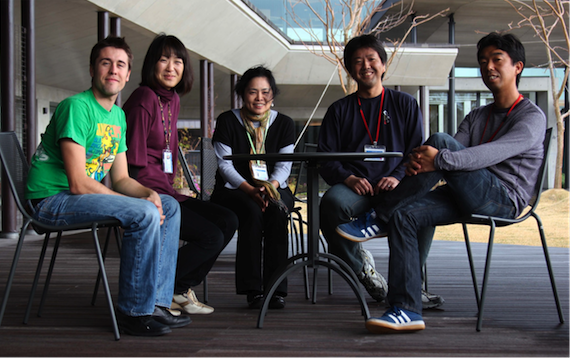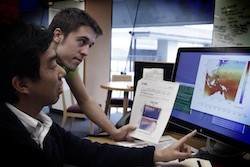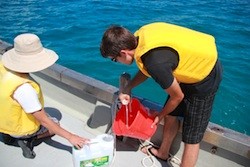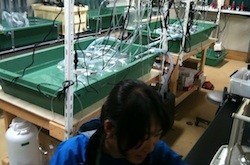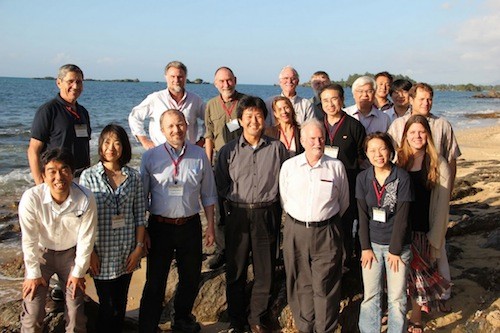Marine Biophysics Unit
Independent New Investigator: Satoshi Mitarai
Research Theme: Marine Environmental Science
Abstract
Marine Biophysics Unit will develop forecasting system for the coastal ocean circulation processes around Okinawa and implement a validated connectivity assessment tool, coupling available modeling and observation techniques. This modeling tool will i) help marine biologists and geneticists estimate rates of gene flow among sites, ii) enable public agencies to build and evaluate marine protected areas based on population connectivity, and iii) provide marine ecologists with a modeling system for predicting the global and long-term dynamics of the marine ecosystem. Marine Biophysics Unit was established on Sep 1, 2009 when Satoshi Mitarai joined OIST.
1. Staff
1.1 Researchers
- Satoshi Mitarai (Independent New Investigator, September 2009–)
- Taichiro Sakagami (Technical staff, February 2010–)
- Masako Nakamura (Researcher, March 2010–)
1.2 Administraters
- Shizuka Kuda (Secretary, February 2010–)
- Yukiko Murabayashi (Research coordinator, July 2011–)
1.3 Internship students
- Emile Trimoreau (September 2010–February 2011)
- Flora Vincent (July 2011–December 2011)
2. Collaborations
2.1 Larval dispersal of coral reef species
- K. Sakai (University of the Ryukyus) *
- D. Siegel, R. Warner and J. Caselle (University of California, Santa Barbara)
- P. Barbar (University of California, Los Angeles)
2.2 Larval dispersal of hydrothermal vent species
- T. Maruyama, Y. Fujiwara, Y. Furushima and H. Watanabe (Japan Agency for Marine-Earth Sci. and Tech.)
- S. Beaulieu (Woods Hole Oceanographic Institution)
2.3 Regional ocean circulation modeling
- J. McWilliams, J. Molemaker and A.Shchepetkin (University of California, Los Angeles)
- E. Gross and O. Flinger (Stanford University)
- Y. Uchiyama (Kobe University)
2.4 Okinawa coastal ocean observing system
- S. Monismith and J. Koseff (Stanford University)
- A. Genin (Hebew Universirty of Jerusalem)
- L. Legendre (Laboratoire d'Oceanographie de Villefranche)
- J. Mitchell (Flinders University)
- H. Yamazaki (Tokyo Instutute of Marine Science and Technology)
- S. Gallager (Woods Hole Oceanographic Institution)
- K. Hirate (Okinawa Prefectural Fisheries and Ocean Research Center)
- H. Furukawa, K. Muneda and I. Tedokon (Japan Coast Guard 11th Head Quarter)
* indicates that a joint research agreement has been established.
3. Activities and Findings
3.1 Coastal ocean circulation modeling
We have been developing high-resolution ocean circulation simulation for Okinawa using the Regional Ocean Modeling System. We plan to build three-level nested grids. We are finished with two grids: 1) coarse (12.5 km horizontal resolution) that covers the Pacific ocean and 2) medium (4 km resolution) that covers the north of Philippine, Taiwan, and the Ryukyu islands. We are examining the simulation results against available observation data. We will soon start developing the finest grid (500 m) that covers Okinawa Islands.
3.2 Coastal ocean observations
In collaboration with Prof. Hide Yamazaki, we made field observations along the shore in front of OIST main campus. Using a profiler, we measured and computed physical parameters (temperature, salinity, density, turbidity and chlorophyle a). We also took water samples for Evolutionary Systems Biology Unit (Photo). The aim is to assess marine microorganisms community diversity, dispersal processes and global dynamics. No definitive results have been obtained by now but trials outputs were encouraging.
3.3 Coral larvae under ocean acidification
Ocean acidification is one of the ongoing threads for marine organisms, resulting from the increase level of carbon dioxide in the atmosphere. Ocean acidification may greatly impact larval development and their dispersal ability. We observed transcription levels of heat shock proteins (expressed under stressful conditions to repair damaged proteins) in larvae of a coral species Acropora digitifera under acidified conditions with several different levels.
4. Publications
4.1 Journals
Fiscal year 2009- S. Mitarai, D. A. Siegel, J. R. Watson, C. Dong, and J. C. McWilliams. Quantifying connectivity in the coastal ocean with application to the Southern California Bight. Journal of Geophysical Research–Oceans, 114, Oct. 2009.
- H. A. Berkley, B. E. Kendall, S. Mitarai, and D. A. Siegel. Turbulent dispersal promotes species coexistence. Ecology Letters, 13(3):360–371, Mar. 2010.
- J. R. Watson, S. Mitarai, D. A. Siegel, J. E. Caselle, C. Dong, and J. C. McWilliams. Realized and potential larval connectivity in the Southern California Bight. Marine Ecology-Progress Series, 401:31–48, 2010.
- K. A. Selkoe, J. R. Watson, C. White, T. Ben Horin, M. Iacchei, S. Mitarai, D. A. Siegel, S. D. Gaines, and R. J. Toonen. Taking the chaos out of genetic patchiness: seascape genetics reveals ecological and oceanographic drivers of genetic patterns in three temperate reef species. Molecular Ecology, 19(17):3708– 3726, 2010.
- J. C. Ohlmann and S. Mitarai. Lagrangian assessment of simulated surface current dispersion in the coastal ocean. Geophysical Research Letters, 37, 2010.
- Nakamura, M., Ohki, S., Suzuki, A., and Sakai, K. Coral larvae under ocean acidification: survival, metabolism, and metamorphosis, PLoS One 6(1):e1452, Jan 2011.
- Alberto, F., Raimondi, P., Reed, D., Watson, J., Siegel, D., Mitarai, S., Coelho, N., and Serrao, E. Isolation by oceanographic distance explains genetic structure for Macrocystis pyrifera in the Santa Barbara Channel, Molecular Ecology, doi: 10.1111/j.1365-294X.2011.05117.x, May 2011.
- Watson, J., Hays, C., Raimondi, P., Mitarai, S., Dong, C., McWilliams, J., Blanchette, C., Caselle, J. and Siegel, D., Currents connecting communities: nearshore community similarity and ocean circulation, Ecology, 92(6), pp.1193-1200, June 2011.
4.2 Books and other one-time publications
4.3 Oral and Poster Presentations
Fiscal year 2010- Nakamura, M., Ohki S., Suzuki, A. and Sakai, K., “Metabolism and Metamorphosis of Coral Larvae in Acidified Seawater”, PICES, Sendai, Japan, Apr 2010.
- Nakamura, M. and Sakai, K. “Biological and physical factors affecting recruitment variability of spawning corals at local scale-implications for dispersal”, 9th Larval Biology Symposium, Wellington, New Zealand, Aug 23–27, 2010.
- Nakamura, M., Morita, M., Suzuki, A., Sakai, K. and Mitarai, S., “How do coral larvae respond to change in ocean pH?”, 9th Larval Biology Symposium, Wellington, New Zealand, Aug 23–27, 2010.
- Nakamura, M., Morita, M., Kurihara, H., and Mitarai, S., “Effect of acidified seawater on hsp gene expressions in coral larvae”, Okinawa IPCC OAEM side event, Intergovernmental Panel on Climate Change, Nago, Okinawa, Jan 16, 2011.
- Sakagami, T., and Barber, R., “Seasonal cycle of chlorophyll biomass in Peru coastal upwelling ecosystem”, 2011 ASLO Aquatic Sciences Meeting, American Society for Limnology and Oceanography, San Juan, Puerto Rico, Feb 13–18, 2011.
- Nakamura, M., Morita, M., Kurihara, H., and Mitarai, S.,”Gene expression of hsps in coral larvae under acidified conditions”, 2011 ASLO Aquatic Sciences Meeting, American Society for Limnology and Oceanography, San Juan, Puerto Rico, Feb 13–18, 2011.
5. Intellectual Property Rights and Other Specific Achievements
5.2 Other funding
- FY 2011 Special Framework Budget, Japanese Government, “Okinawa Coastal Ocean Observing System”, Lead PI: S. Mitarai, Amount: 400 Million Yen.
5.3 Honors and awards
6. Meetings and Events
6.1 OIST International Workshop on Computational Ecology
Organizer: Satoshi Mitarai (OIST)
Co-organizer: Dave Robertson (University of Edinburgh)
Dates: Dec 1–3, 2010
Place: OIST Seaside House / OIST campus
Co-organizer: Dave Robertson (University of Edinburgh)
Dates: Dec 1–3, 2010
Place: OIST Seaside House / OIST campus
- Robert Warner (University of California, Santa Barbara, USA)
- Stephen Monismith (Stanford University, USA)
- Amaztia Genin (Hebrew University of Jerusalem, Israel)
- Louis Legendre (Laboratoire d'Oceanographie de Villefranche, France)
- James Mitchell (Flinders University, Australia)
- Hidekatsu Yamazaki (Tokyo Institute of Marine Science and Technology, Japan)
- Paul Barber (University of California, Los Angeles, USA)
- Jennifer Caselle (University of California, Santa Barbara, USA)
- David Robertson (University of Edinburgh, UK)
- Malcolm Atkinson (University of Edinburgh, UK)
- Siu-Wai Leung (University of Macau, China)
- Fang-Pang Lin (National Center for High Performance Computing, Taiwan)
- Scott Gallager (Woods Hole Oceanographic Institution, USA)
- Amber York (Woods Hole Oceanographic Institution, USA)






